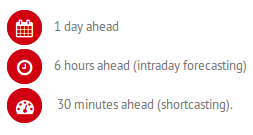This article was originally published on SolarChoice. Re-produced with permission.
Reuniwatt is a solar forecasting company born out of some of the most stringent electricity market conditions on the planet. Founded on France’s Reunion Island, Reuniwatt’s Soleka forecasting tool has been designed to meet the strict reliability standards of an island grid heavily reliant on medium and large-scale solar farms, and is of potential interest and use to energy traders, transmission & distribution system operators, regulators and micro-grid operators.
Solar forecasting: It’s all about stability
One of the biggest potential issues with solar farms on the grid is the predictability of the energy that they produce. Electricity networks must constantly strike a balance between energy demand and energy supply – otherwise blackouts and other issues can occur. This downside – the issue of intermittency – has long been used by opponents of greater uptake of renewables (mainly wind and solar) to argue that large-scale solar plants have no place on the grid.
But large-scale solar projects are being built regardless (in fact Solar Choice has a number in the works, and a handful of others have come online in the last 12 months) – and Australia is actually behind the global curve, despite the support of the federal Renewable Energy Target. In order to bid into the National Electricity Market, these solar farms need to know with a high degree of accuracy when they’re going to have solar resources available and how much they can expect them to produce.
One option would be to use batteries to ‘smooth out’ the solar production curve, but battery storage remains pricey – at least for the time being. But even with battery storage, it would remain crucial for solar plant operators to understand in advance what sort of production they can expect.
Forecasting solar plant output with Soleka
Soleka uses a sophisticated solar forecasting tool using data collected from a network of sensors, satellite observations and meteorological modelling to provide high-fidelity predictions about the timing and strength of solar irradiation in a given spot. With this data, renewable energy plant operators and traders are able to quickly and easily determine how much solar energy they’ll have at their disposal in one day, in six hours or even in 30 minutes – and set expectations and plans accordingly.
We caught up with with Reuniwatt’s Antonin Braun to ask some questions about Soleka’s capabilities and to learn about instances where it has been put to practical use.
Q: How has Soleka been used on island grids?
A good example of the use of Soleka on an island grid is Reuniwatt’s ‘home base’: The French territory of Reunion Island.
In non-interconnected insular areas, the share of renewable energies in the energy mix can already be substantial. In the middle of the day, the share of solar can reach over 30% on Reunion Island (334,000 customers), a French island in the Indian Ocean located close to Mauritius. This level is considered a threshold: beyond this level, PV variability begins to have noticeable impacts on grid operations. In order to limit the load variability constraints on the networks, photovoltaic electricity producers have to follow a load profile with a trapeze shape. They also have to announce the maximum power delivered. In order to respect this profile, they have to associate their production equipment with an energy storage solution. Any non-compliance with the announced profile leads to fines.
Reuniwatt provides forecasting data to an electricity producer for a 946kW photovoltaic power plant coupled to a 1,200kWh lithium-ion storage solution located on the rooftop of a commercial centre in Saint-Leu, Reunion Island. These data are provided at different time horizons, ranging from 15 minutes to 48 hours. They are integrated in the Energy Management System (EMS), the IT management system of the solar power plant and the batteries that analyse the data in order to inject an appropriate amount of power into the grid.
Thanks to Reuniwatt’s forecasts, this operator has managed to completely avoid fines over the past 2 years and has increased by more than 5% the amount of solar energy he sells daily to the grid.
Q: How does Reuniwatt’s technology apply in Australia for solar farms?
Our technology has many applications for solar on the Australian grid:
- Our long term forecasting (from 6h ahead to several days ahead) can help network providers and regulators to add stability to the grid and avoid waste of energy. With the forecast information they are able to start or stop other means of production (open a dam, for example) ahead of time to manage to have the exact right amount of electricity in the grid
- Our intra-day forecasting (between 1 to 6 hours ahead) can help:
- Solar farms operators to manage their stocks in a competitive energy market and allow them to choose when it will be best to sell the energy.
- Energy traders and utility companies to use the data to better forecast or adjust the energy prices and optimize their systems.
- The network providers to optimize their other energy production source to provide only the necessary additional amount of energy required by the grid and avoid the economic and environmental cost of wasted energy.
- Consumers with private solar+battery could use our system to optimizes when to buy from the grid and when to self-consume, based on the weather forecast.
- Finally our intra-hour forecasting (from 30 s to 1h ahead) can help :
- Solar farms operators to better manage their battery life cycle, by only turning on and off the batteries when needed.
- Off-grid systems to significantly decrease the consumption of gas or diesel in hybrid PV systems (PV-diesel or PV-gas). By forecasting if a cloud is going to bring a significant drop in the next 5 minutes, you allow the grid operator to increase the PV penetration in the system and lower the spinning reserve.
Q: Is there potential for Soleka to be used for forecasting output from distributed resources (like rooftop solar)?
For power distribution utilities, forecasting the distributed solar production allows for better management of the constraints on the electrical network at a source substation level and improve their net load forecasts while taking into account behind-the-meter solar (which for the time being is largely invisible to the stakeholders). Solar systems equipped with storage batteries will appear everywhere, on-grid as well as off-grid and on centralized or distributed grids. Due to the testing of diverse sizing and management strategies, we will be able to select the best use cases. Solar forecasting can be considered a moderate cost decision-making tool, which represents an opportunity to optimize the strain on the batteries and to improve the electric system’s profitability
For example we provide more than 150.000 forecasts across Germany to German energy traders. This real-time updated data helps them better forecast the energy market’s prices and optimise their investments.


